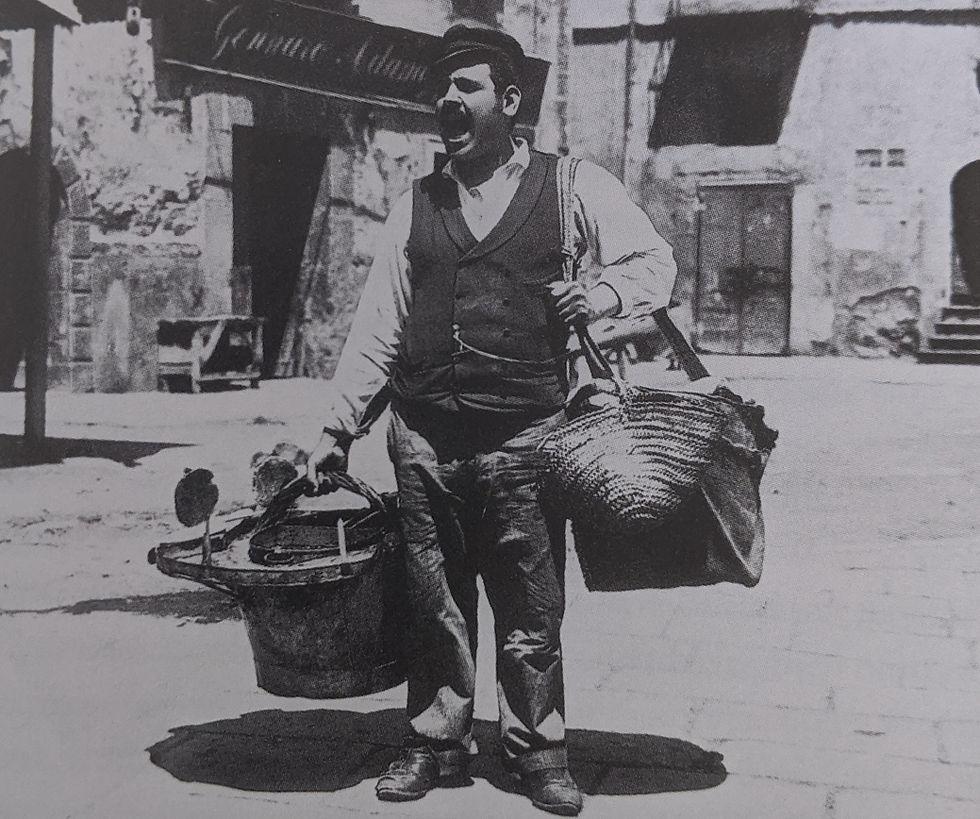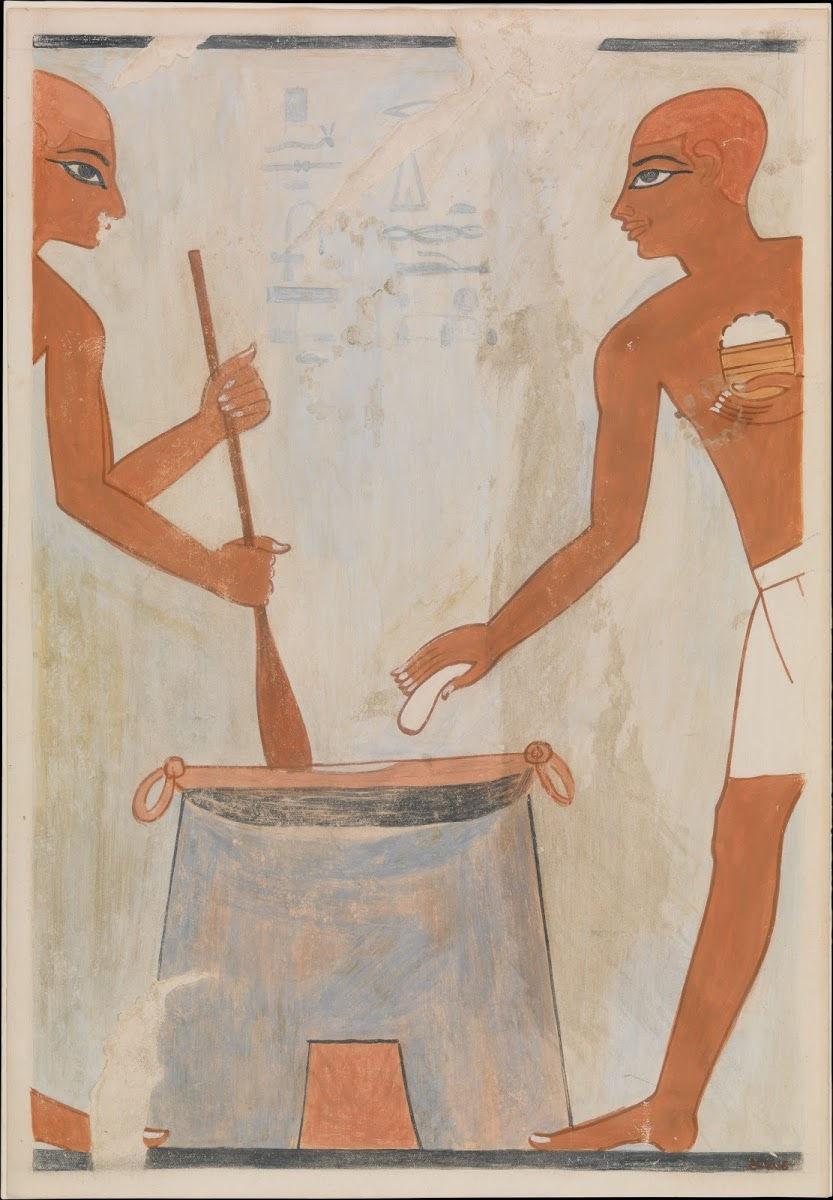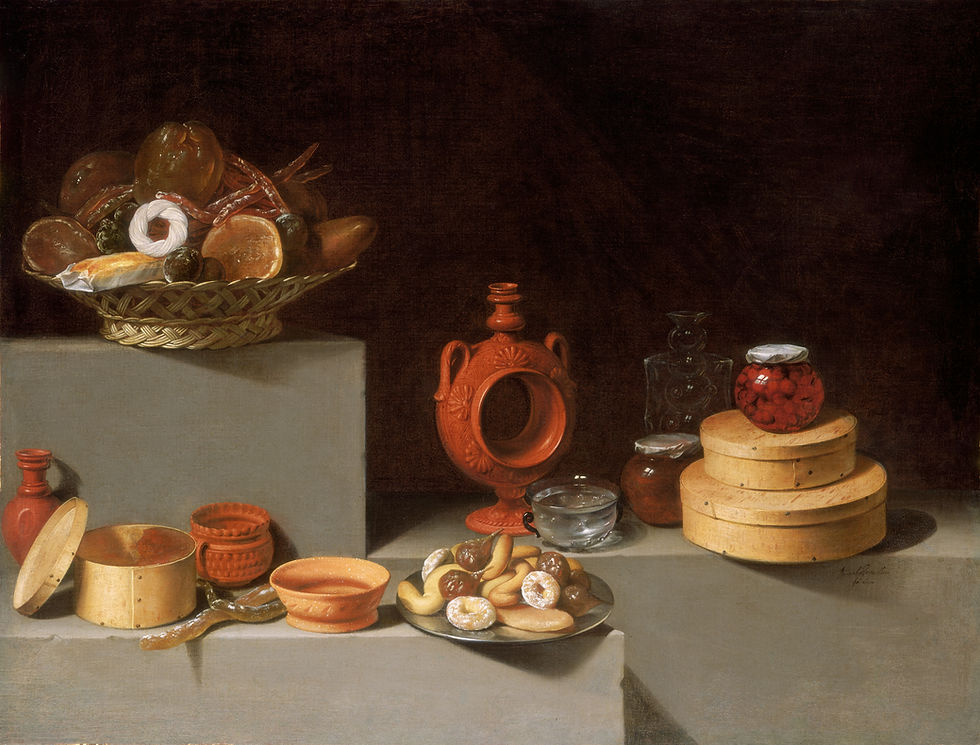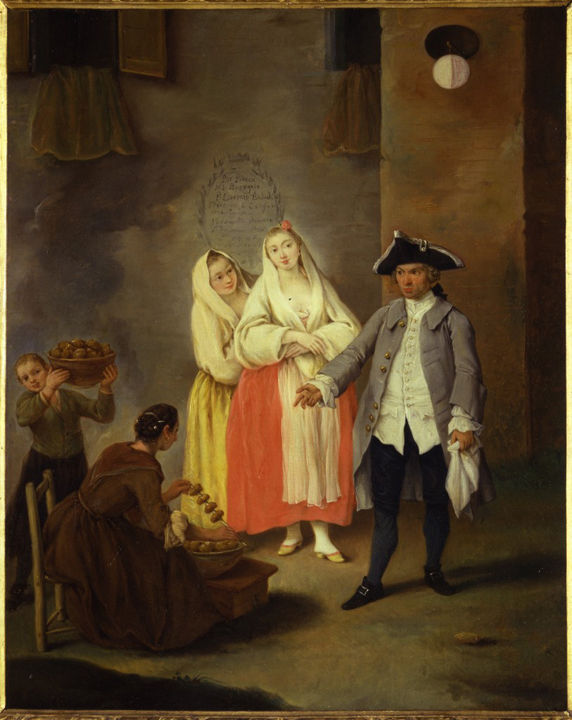The Roman Contribution to the Doughnut
- Aug 27, 2020
- 5 min read

Venetian fritoler with portable fryer c. 1900.
Sweetness has always been prized. Cave paintings near Valencia dated to around 8000 BC depict early attempts at stealing honey from the bees. While others learned to process the sap of local plants such as sorghum and palms. Sugar cane was cultivated as long ago as 7000 BC in Papua New Guinea though millennia passed before it found its way westwards to India.
Cuneiform records reveal a fondness for fermented liquids (implying a familiarity with yeast and fermentation beyond that required for the baking of bread) among the Sumerians. But the evidence points to an Egyptian origin (c. 4000 BC) for the first leavened breads. They were made from flours from the first cultivated varieties of wheat that did not require toasting to allow the grains to be threshed cleanly.[1]
Dough made from these new flours and cooked in exotic oils quickly became high-status foods. A wall-painting in the tomb of Rekhmire, vizier to the pharaoh Thutmose III, bearing the caption “put in the fat and cook the cake” is a very early image that displays the deep-frying of dough.
So far we have a fried blob of dough, but nothing sweet. Fortunately, the Greeks ride to the rescue, which can’t come as a surprise considering they were a people whose junior priests (called skyophants “fig revealers”) were charged with announcing the start of the fig season – a title that quickly took on its pejorative meaning when it was used to describe informers who reported the illegal export of figs from Attica.

Cooking cakes with fat, tomb of Rekhmire, c. 1504-1425 BC; modern facsimile by Nina de Garis Davies.
Sweet figs aside, it’s Greek honey that provides the magic touch to our dough in the poet Callimachus (c. 250 BC) who referred to “honey tokens” i.e. fried balls of dough covered in honey as one of the prizes awarded to winners of the Olympics.[2] Even the Spartans (famous for their rather grim melas zomos) allowed their women to indulge in the sweet treat khrysokolla (literally “inlaid with gold”), described by Alcman in the seventh century BC as baskets of honeyed sweets.
Many of the Roman sweets, called dulcia, were also based on honey as sugar was prohibitively expensive.[3] Often they were pastries (with names like liba and savillum) smothered with fresh cuts of honeycomb. The first known recipes for honey cakes come from Cato the Elder.[4] His second-century BC treatise De Agri Cultura (On Agriculture) was a manual on how his rural estates should be run including its festivities.[5] The entry for globi (balls) runs as follows:
“Globi are a mix of cheese and emmer: make as many balls as you want. Put fat in a hot bronze pan; cook one or two at a time, turning them frequently with two sticks. When cooked remove them, coat in honey, roll in poppy-seeds. Serve.”

Juan van der Hamen y Leon, Still life with Sweets and Pottery, 1627.
The problem is there is no mention of fermenting or leavening. Perhaps Cato thought the reader would have been aware of the desired result and did not need his instructions. The product, however, produces more of a fried cheesecake than a doughnut. His recipe for encytum (immediately following that of globi) uses the same cheesy batter but he continues
“You use a deep pierced dish with which you stream into the hot fat; form neatly as with spira [a pastry of rolled dough ropes coiled artistically]”.
The results – and he warns against over-cooking them – are coated in honey syrup. Given that the dough for globi is formed into balls, the dough for encytum must have required thinning to allow it to stream through the holes in the dish. One of Apicius’ sweets offered a slightly odd variation in which the flour and water were boiled and reduced to a hard paste, cut in pieces, left to cool, fried in oil, drenched in honey and then sprinkled with pepper.
The Arabs, avid imitators of Romanitas, soon followed suit. One receipe from the thirteenth century Kitab Wasf (Book of Familiar Foods) has the following recipe:
“Take some of the mentioned batter and put it in a coconut pierced at the bottom. Then put your finger on the hole and fill it with batter. Then put sesame oil in the cauldron, and when it boils, you take your finger from the hole and move your hand around. Rings of latticework are created. So take them up and throw them in syrup.”

Pietro Longhi, The Seller of Fritters, c. 1750.
The similarities with the Roman encytum are obvious. But while there’s a continuity of technique, the ingredients differ. By the thirteenth century the batter for zulabiya (AKA mushabbalak) contained no cheese. And when the Germanics stopped eating mud – in roughly the tenth century – the demand for cooking manuscripts went through the roof. Sadly, the Latins were too often embarrassed to steal cultural aspects from their Roman cousins directly and so they turned to the Arabs for (bypassed) inspiration. Charles II the (Angevin) king of Naples, for instance, had Liber de ferculis (Book of Dishes) translated in Venice[6] from Arabic by one very Swahili-sounding Jamboninus and it contained a recipe for Roman doughnuts (kneaded into ground almonds, sugar and a little camphor, boiled in sesame oil and rolled in syrup).[7]
Further Reading: “Cato’s Cakes,” The Classical Journal, Vol. 38., No. 4 (Jan., 1943), pp. 213-221.
[1] Toasting wheat denatures its gluten. Before this innovation all breads were essentially flatbreads.
[2] The best hunting ground for honey was Mount Hymettus near Athens where the honey had (and still has) a savour of thyme. Honey obtained without smoking the bees out (therefore leaving the honey with an uncontaminated flavour) was the best of all and a little like bacon today was known as akapniston (unsmoked). Archestratus (c. 330 BC) recommended a thin pancake drenched in honey from Attica in The Life of Luxury.
[3] The first reference to sugar in classical literature is attributed to Nearchus of Crete, the general who commanded the returning fleet of Alexander the Great’s army in 327 BC and came across sugar cane in what is now the Punjab, as he sailed from the Indus to the Euphrates. It didn’t really become a staple of the Eastern Mediterranean until AD 1000 when sugar industries in Yemen, Ethiopia and Zanzibar were stablished. And even then it was appreciated more for the sparkly lustre it gave food than for its taste e.g. the Kitab al-Tabikh’s aruzza (a rice dish) “has sugar sprinkled on it so it flashes and gleams like light itself.”
[4] Though honey cakes feature in the records of the Carthaginian and Phoenician peoples of the first millennium BC we don’t know what recipes they followed.
[5] The suitability of including cooking recipes in a book on farming was questioned by Varro but the manual in all probability started off as a collection of private notes.
[6] In Italy, doughnuts would go native by becoming the fritole, which were traditionally made of yeasted dough with a dash of grappa or anise and touted by the fritoler with his portable fryer; they were so popular that by the eighteenth century they had their own guild.
[7] Jambo! means “hello!” in Swahili.







Comments